Self-Reflection on Workplace Violence in Nursing Practice (GRN)
VerifiedAdded on 2020/03/23
|9
|3255
|48
Journal and Reflective Writing
AI Summary
This self-reflection assignment, created by a student, examines an instance of workplace violence encountered in a nursing setting, specifically within an emergency department. Using the 5Rs Reflection Framework (Reporting, Responding, Relating, Reasoning, and Reconstructing), the assignment details an incident where a patient exhibited aggressive behavior. The reflection explores the emotional and professional impacts of the event, including feelings of disrespect and the challenges faced due to workload and lack of experience. It connects the incident to broader issues in healthcare, such as the increasing rate of 'code blacks' and the shortage of nurses, highlighting the potential for workplace violence. The assignment then analyzes contributing factors like poor management practices and lack of training, while also proposing strategies for future practice, including participation in workplace violence prevention programs, utilizing available resources, and taking self-defense classes. The goal is to restructure nursing practice to better handle and prevent similar situations, acknowledging the importance of supporting healthcare workers. The assignment is available on Desklib, a platform offering AI-based study tools.
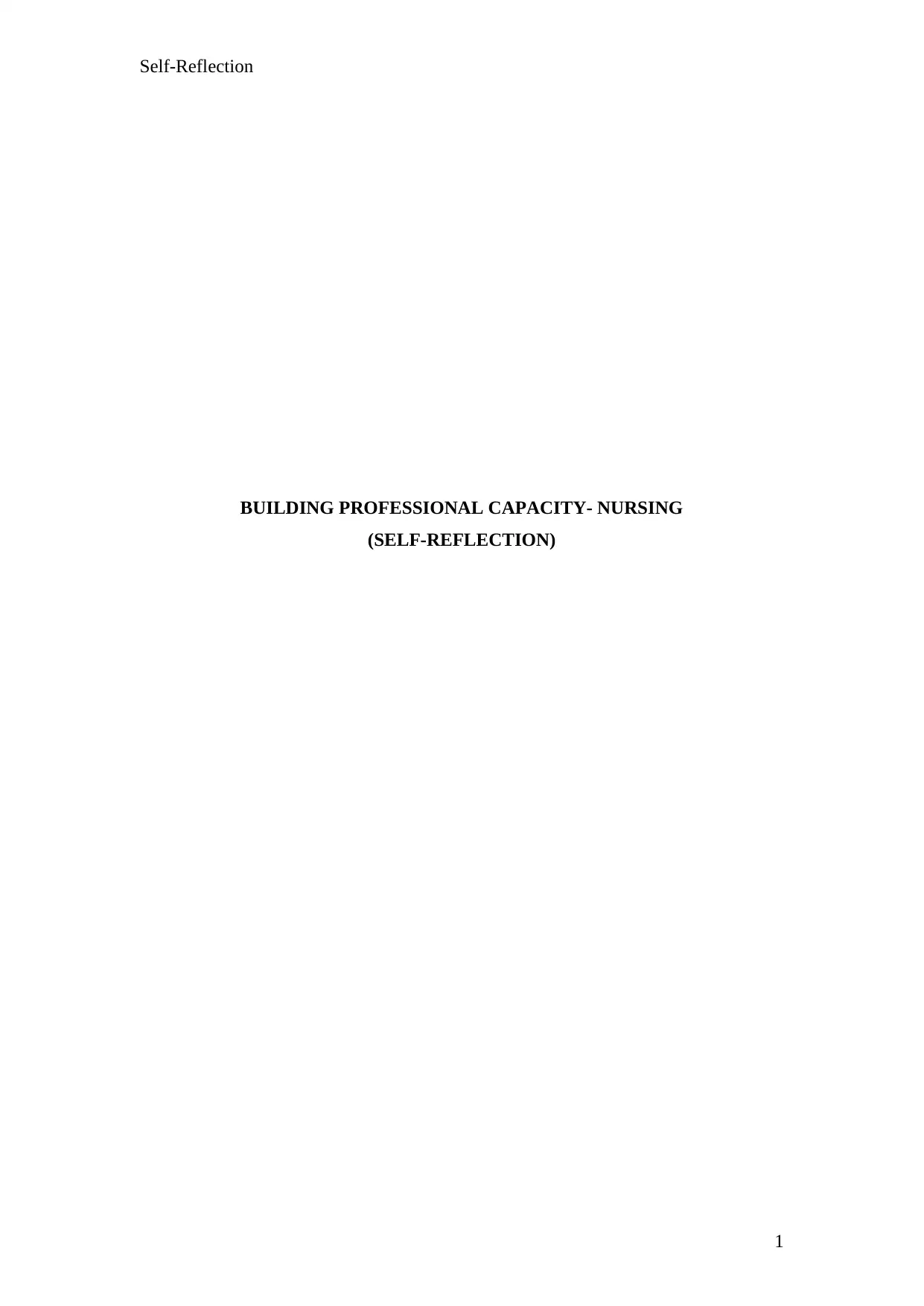
Self-Reflection
BUILDING PROFESSIONAL CAPACITY- NURSING
(SELF-REFLECTION)
1
BUILDING PROFESSIONAL CAPACITY- NURSING
(SELF-REFLECTION)
1
Paraphrase This Document
Need a fresh take? Get an instant paraphrase of this document with our AI Paraphraser
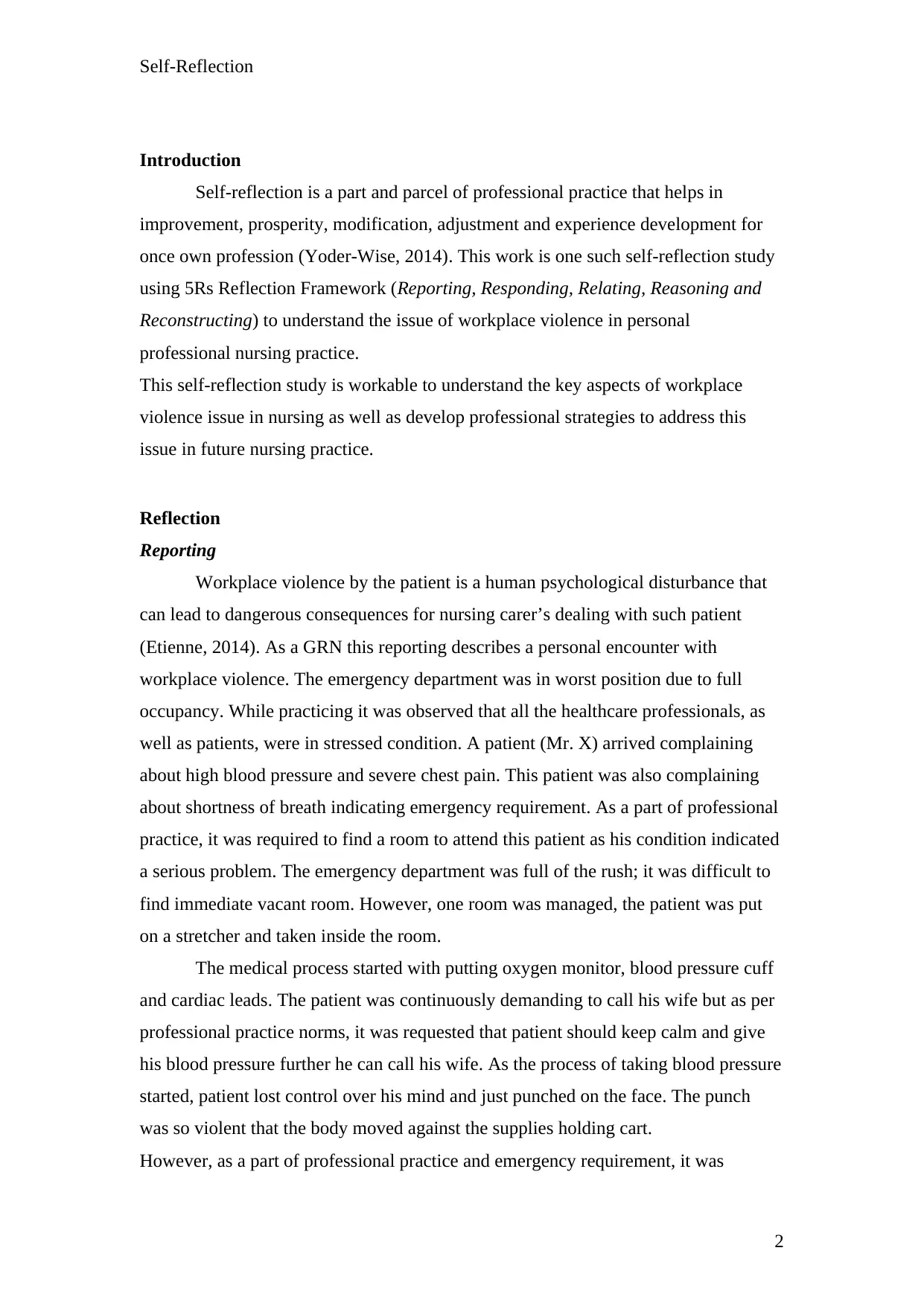
Self-Reflection
Introduction
Self-reflection is a part and parcel of professional practice that helps in
improvement, prosperity, modification, adjustment and experience development for
once own profession (Yoder-Wise, 2014). This work is one such self-reflection study
using 5Rs Reflection Framework (Reporting, Responding, Relating, Reasoning and
Reconstructing) to understand the issue of workplace violence in personal
professional nursing practice.
This self-reflection study is workable to understand the key aspects of workplace
violence issue in nursing as well as develop professional strategies to address this
issue in future nursing practice.
Reflection
Reporting
Workplace violence by the patient is a human psychological disturbance that
can lead to dangerous consequences for nursing carer’s dealing with such patient
(Etienne, 2014). As a GRN this reporting describes a personal encounter with
workplace violence. The emergency department was in worst position due to full
occupancy. While practicing it was observed that all the healthcare professionals, as
well as patients, were in stressed condition. A patient (Mr. X) arrived complaining
about high blood pressure and severe chest pain. This patient was also complaining
about shortness of breath indicating emergency requirement. As a part of professional
practice, it was required to find a room to attend this patient as his condition indicated
a serious problem. The emergency department was full of the rush; it was difficult to
find immediate vacant room. However, one room was managed, the patient was put
on a stretcher and taken inside the room.
The medical process started with putting oxygen monitor, blood pressure cuff
and cardiac leads. The patient was continuously demanding to call his wife but as per
professional practice norms, it was requested that patient should keep calm and give
his blood pressure further he can call his wife. As the process of taking blood pressure
started, patient lost control over his mind and just punched on the face. The punch
was so violent that the body moved against the supplies holding cart.
However, as a part of professional practice and emergency requirement, it was
2
Introduction
Self-reflection is a part and parcel of professional practice that helps in
improvement, prosperity, modification, adjustment and experience development for
once own profession (Yoder-Wise, 2014). This work is one such self-reflection study
using 5Rs Reflection Framework (Reporting, Responding, Relating, Reasoning and
Reconstructing) to understand the issue of workplace violence in personal
professional nursing practice.
This self-reflection study is workable to understand the key aspects of workplace
violence issue in nursing as well as develop professional strategies to address this
issue in future nursing practice.
Reflection
Reporting
Workplace violence by the patient is a human psychological disturbance that
can lead to dangerous consequences for nursing carer’s dealing with such patient
(Etienne, 2014). As a GRN this reporting describes a personal encounter with
workplace violence. The emergency department was in worst position due to full
occupancy. While practicing it was observed that all the healthcare professionals, as
well as patients, were in stressed condition. A patient (Mr. X) arrived complaining
about high blood pressure and severe chest pain. This patient was also complaining
about shortness of breath indicating emergency requirement. As a part of professional
practice, it was required to find a room to attend this patient as his condition indicated
a serious problem. The emergency department was full of the rush; it was difficult to
find immediate vacant room. However, one room was managed, the patient was put
on a stretcher and taken inside the room.
The medical process started with putting oxygen monitor, blood pressure cuff
and cardiac leads. The patient was continuously demanding to call his wife but as per
professional practice norms, it was requested that patient should keep calm and give
his blood pressure further he can call his wife. As the process of taking blood pressure
started, patient lost control over his mind and just punched on the face. The punch
was so violent that the body moved against the supplies holding cart.
However, as a part of professional practice and emergency requirement, it was
2
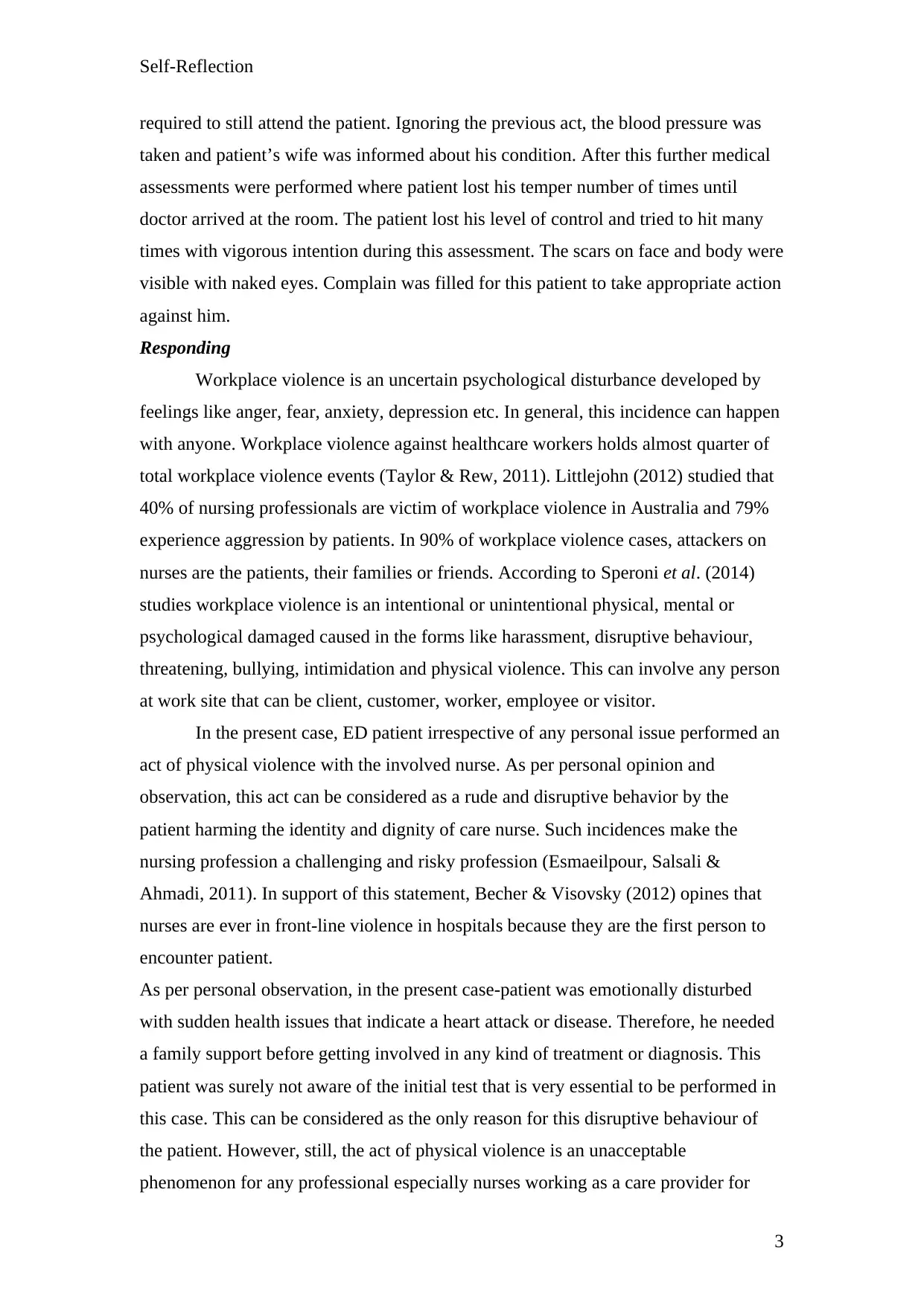
Self-Reflection
required to still attend the patient. Ignoring the previous act, the blood pressure was
taken and patient’s wife was informed about his condition. After this further medical
assessments were performed where patient lost his temper number of times until
doctor arrived at the room. The patient lost his level of control and tried to hit many
times with vigorous intention during this assessment. The scars on face and body were
visible with naked eyes. Complain was filled for this patient to take appropriate action
against him.
Responding
Workplace violence is an uncertain psychological disturbance developed by
feelings like anger, fear, anxiety, depression etc. In general, this incidence can happen
with anyone. Workplace violence against healthcare workers holds almost quarter of
total workplace violence events (Taylor & Rew, 2011). Littlejohn (2012) studied that
40% of nursing professionals are victim of workplace violence in Australia and 79%
experience aggression by patients. In 90% of workplace violence cases, attackers on
nurses are the patients, their families or friends. According to Speroni et al. (2014)
studies workplace violence is an intentional or unintentional physical, mental or
psychological damaged caused in the forms like harassment, disruptive behaviour,
threatening, bullying, intimidation and physical violence. This can involve any person
at work site that can be client, customer, worker, employee or visitor.
In the present case, ED patient irrespective of any personal issue performed an
act of physical violence with the involved nurse. As per personal opinion and
observation, this act can be considered as a rude and disruptive behavior by the
patient harming the identity and dignity of care nurse. Such incidences make the
nursing profession a challenging and risky profession (Esmaeilpour, Salsali &
Ahmadi, 2011). In support of this statement, Becher & Visovsky (2012) opines that
nurses are ever in front-line violence in hospitals because they are the first person to
encounter patient.
As per personal observation, in the present case-patient was emotionally disturbed
with sudden health issues that indicate a heart attack or disease. Therefore, he needed
a family support before getting involved in any kind of treatment or diagnosis. This
patient was surely not aware of the initial test that is very essential to be performed in
this case. This can be considered as the only reason for this disruptive behaviour of
the patient. However, still, the act of physical violence is an unacceptable
phenomenon for any professional especially nurses working as a care provider for
3
required to still attend the patient. Ignoring the previous act, the blood pressure was
taken and patient’s wife was informed about his condition. After this further medical
assessments were performed where patient lost his temper number of times until
doctor arrived at the room. The patient lost his level of control and tried to hit many
times with vigorous intention during this assessment. The scars on face and body were
visible with naked eyes. Complain was filled for this patient to take appropriate action
against him.
Responding
Workplace violence is an uncertain psychological disturbance developed by
feelings like anger, fear, anxiety, depression etc. In general, this incidence can happen
with anyone. Workplace violence against healthcare workers holds almost quarter of
total workplace violence events (Taylor & Rew, 2011). Littlejohn (2012) studied that
40% of nursing professionals are victim of workplace violence in Australia and 79%
experience aggression by patients. In 90% of workplace violence cases, attackers on
nurses are the patients, their families or friends. According to Speroni et al. (2014)
studies workplace violence is an intentional or unintentional physical, mental or
psychological damaged caused in the forms like harassment, disruptive behaviour,
threatening, bullying, intimidation and physical violence. This can involve any person
at work site that can be client, customer, worker, employee or visitor.
In the present case, ED patient irrespective of any personal issue performed an
act of physical violence with the involved nurse. As per personal opinion and
observation, this act can be considered as a rude and disruptive behavior by the
patient harming the identity and dignity of care nurse. Such incidences make the
nursing profession a challenging and risky profession (Esmaeilpour, Salsali &
Ahmadi, 2011). In support of this statement, Becher & Visovsky (2012) opines that
nurses are ever in front-line violence in hospitals because they are the first person to
encounter patient.
As per personal observation, in the present case-patient was emotionally disturbed
with sudden health issues that indicate a heart attack or disease. Therefore, he needed
a family support before getting involved in any kind of treatment or diagnosis. This
patient was surely not aware of the initial test that is very essential to be performed in
this case. This can be considered as the only reason for this disruptive behaviour of
the patient. However, still, the act of physical violence is an unacceptable
phenomenon for any professional especially nurses working as a care provider for
3
⊘ This is a preview!⊘
Do you want full access?
Subscribe today to unlock all pages.

Trusted by 1+ million students worldwide
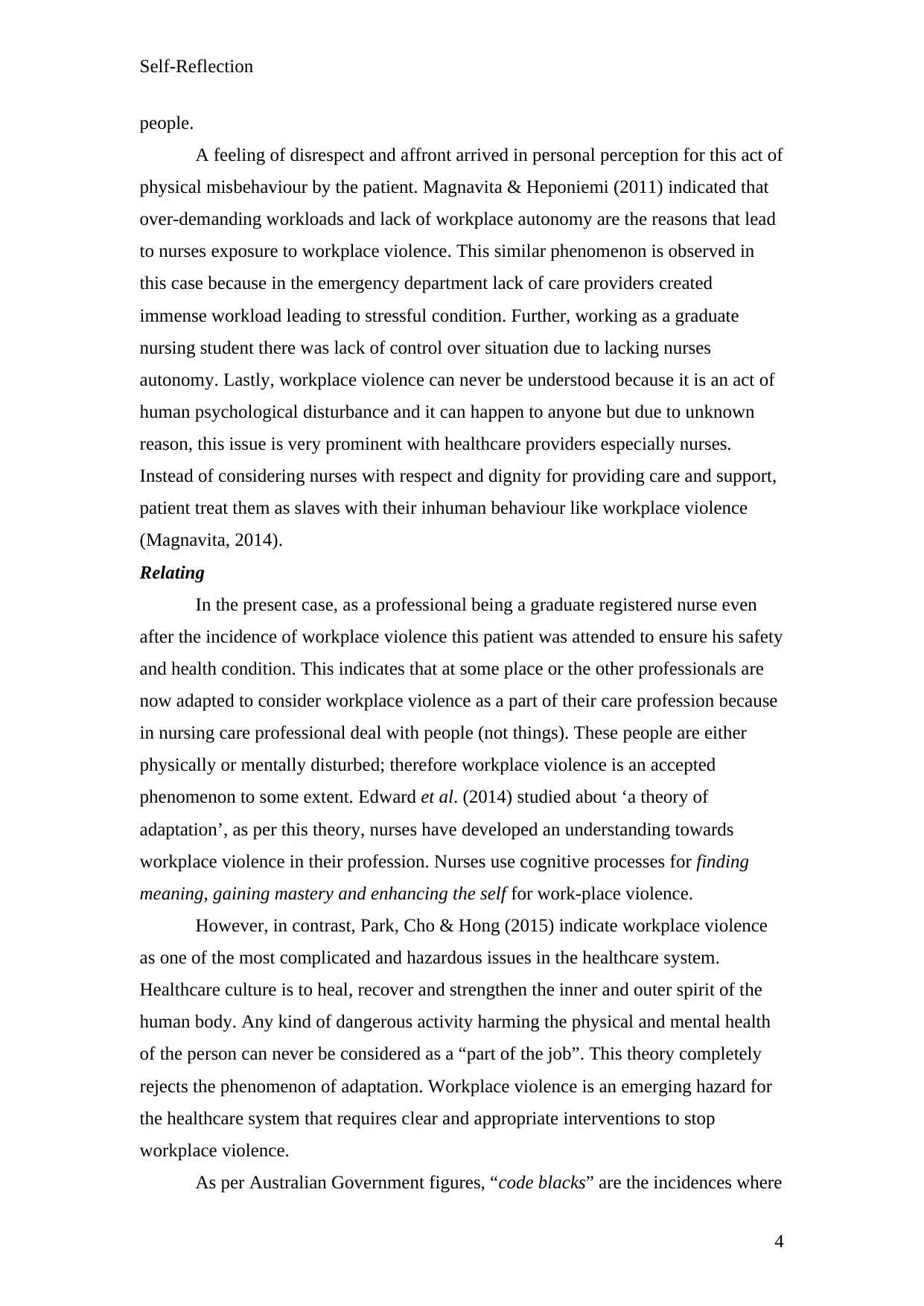
Self-Reflection
people.
A feeling of disrespect and affront arrived in personal perception for this act of
physical misbehaviour by the patient. Magnavita & Heponiemi (2011) indicated that
over-demanding workloads and lack of workplace autonomy are the reasons that lead
to nurses exposure to workplace violence. This similar phenomenon is observed in
this case because in the emergency department lack of care providers created
immense workload leading to stressful condition. Further, working as a graduate
nursing student there was lack of control over situation due to lacking nurses
autonomy. Lastly, workplace violence can never be understood because it is an act of
human psychological disturbance and it can happen to anyone but due to unknown
reason, this issue is very prominent with healthcare providers especially nurses.
Instead of considering nurses with respect and dignity for providing care and support,
patient treat them as slaves with their inhuman behaviour like workplace violence
(Magnavita, 2014).
Relating
In the present case, as a professional being a graduate registered nurse even
after the incidence of workplace violence this patient was attended to ensure his safety
and health condition. This indicates that at some place or the other professionals are
now adapted to consider workplace violence as a part of their care profession because
in nursing care professional deal with people (not things). These people are either
physically or mentally disturbed; therefore workplace violence is an accepted
phenomenon to some extent. Edward et al. (2014) studied about ‘a theory of
adaptation’, as per this theory, nurses have developed an understanding towards
workplace violence in their profession. Nurses use cognitive processes for finding
meaning, gaining mastery and enhancing the self for work-place violence.
However, in contrast, Park, Cho & Hong (2015) indicate workplace violence
as one of the most complicated and hazardous issues in the healthcare system.
Healthcare culture is to heal, recover and strengthen the inner and outer spirit of the
human body. Any kind of dangerous activity harming the physical and mental health
of the person can never be considered as a “part of the job”. This theory completely
rejects the phenomenon of adaptation. Workplace violence is an emerging hazard for
the healthcare system that requires clear and appropriate interventions to stop
workplace violence.
As per Australian Government figures, “code blacks” are the incidences where
4
people.
A feeling of disrespect and affront arrived in personal perception for this act of
physical misbehaviour by the patient. Magnavita & Heponiemi (2011) indicated that
over-demanding workloads and lack of workplace autonomy are the reasons that lead
to nurses exposure to workplace violence. This similar phenomenon is observed in
this case because in the emergency department lack of care providers created
immense workload leading to stressful condition. Further, working as a graduate
nursing student there was lack of control over situation due to lacking nurses
autonomy. Lastly, workplace violence can never be understood because it is an act of
human psychological disturbance and it can happen to anyone but due to unknown
reason, this issue is very prominent with healthcare providers especially nurses.
Instead of considering nurses with respect and dignity for providing care and support,
patient treat them as slaves with their inhuman behaviour like workplace violence
(Magnavita, 2014).
Relating
In the present case, as a professional being a graduate registered nurse even
after the incidence of workplace violence this patient was attended to ensure his safety
and health condition. This indicates that at some place or the other professionals are
now adapted to consider workplace violence as a part of their care profession because
in nursing care professional deal with people (not things). These people are either
physically or mentally disturbed; therefore workplace violence is an accepted
phenomenon to some extent. Edward et al. (2014) studied about ‘a theory of
adaptation’, as per this theory, nurses have developed an understanding towards
workplace violence in their profession. Nurses use cognitive processes for finding
meaning, gaining mastery and enhancing the self for work-place violence.
However, in contrast, Park, Cho & Hong (2015) indicate workplace violence
as one of the most complicated and hazardous issues in the healthcare system.
Healthcare culture is to heal, recover and strengthen the inner and outer spirit of the
human body. Any kind of dangerous activity harming the physical and mental health
of the person can never be considered as a “part of the job”. This theory completely
rejects the phenomenon of adaptation. Workplace violence is an emerging hazard for
the healthcare system that requires clear and appropriate interventions to stop
workplace violence.
As per Australian Government figures, “code blacks” are the incidences where
4
Paraphrase This Document
Need a fresh take? Get an instant paraphrase of this document with our AI Paraphraser
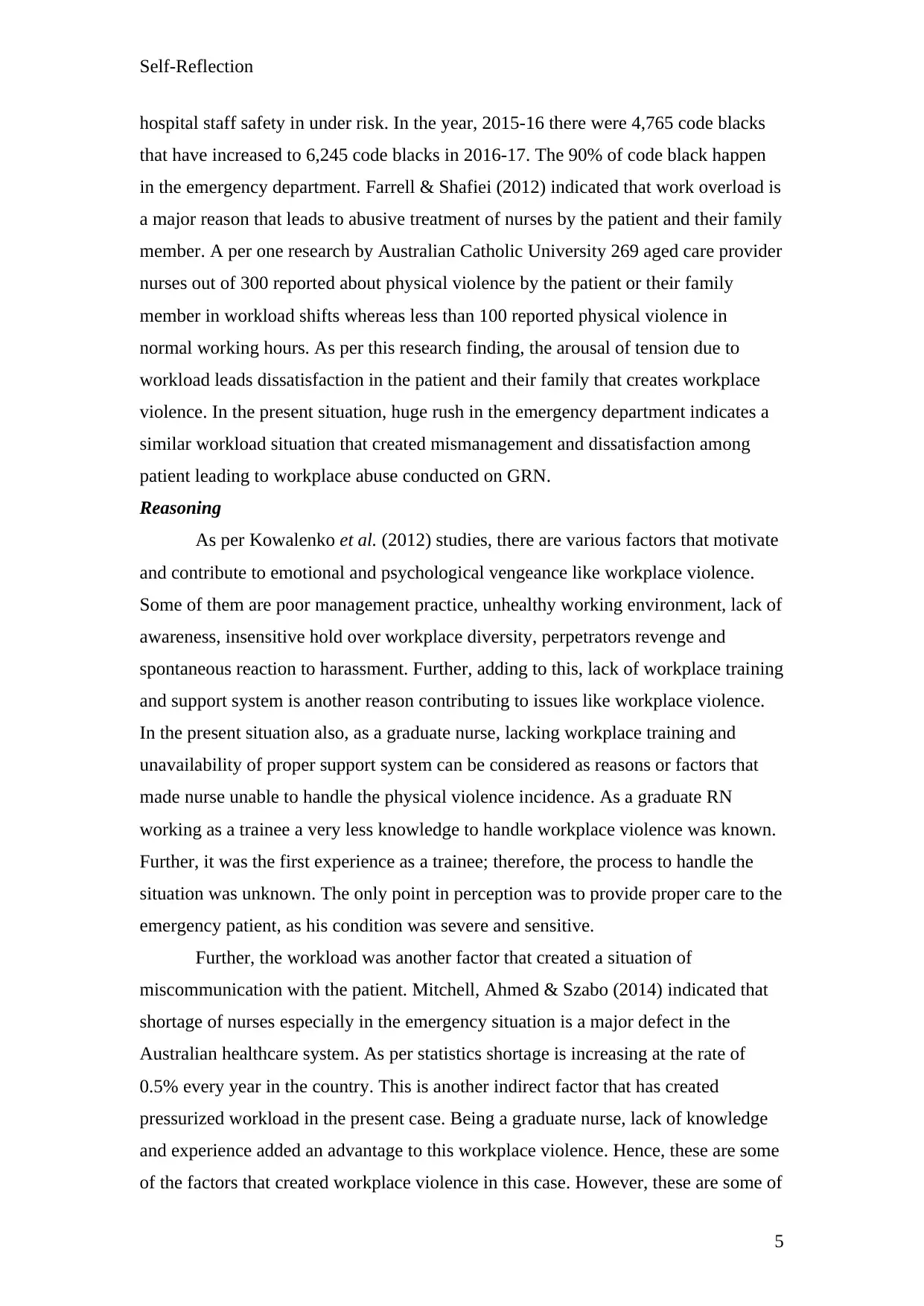
Self-Reflection
hospital staff safety in under risk. In the year, 2015-16 there were 4,765 code blacks
that have increased to 6,245 code blacks in 2016-17. The 90% of code black happen
in the emergency department. Farrell & Shafiei (2012) indicated that work overload is
a major reason that leads to abusive treatment of nurses by the patient and their family
member. A per one research by Australian Catholic University 269 aged care provider
nurses out of 300 reported about physical violence by the patient or their family
member in workload shifts whereas less than 100 reported physical violence in
normal working hours. As per this research finding, the arousal of tension due to
workload leads dissatisfaction in the patient and their family that creates workplace
violence. In the present situation, huge rush in the emergency department indicates a
similar workload situation that created mismanagement and dissatisfaction among
patient leading to workplace abuse conducted on GRN.
Reasoning
As per Kowalenko et al. (2012) studies, there are various factors that motivate
and contribute to emotional and psychological vengeance like workplace violence.
Some of them are poor management practice, unhealthy working environment, lack of
awareness, insensitive hold over workplace diversity, perpetrators revenge and
spontaneous reaction to harassment. Further, adding to this, lack of workplace training
and support system is another reason contributing to issues like workplace violence.
In the present situation also, as a graduate nurse, lacking workplace training and
unavailability of proper support system can be considered as reasons or factors that
made nurse unable to handle the physical violence incidence. As a graduate RN
working as a trainee a very less knowledge to handle workplace violence was known.
Further, it was the first experience as a trainee; therefore, the process to handle the
situation was unknown. The only point in perception was to provide proper care to the
emergency patient, as his condition was severe and sensitive.
Further, the workload was another factor that created a situation of
miscommunication with the patient. Mitchell, Ahmed & Szabo (2014) indicated that
shortage of nurses especially in the emergency situation is a major defect in the
Australian healthcare system. As per statistics shortage is increasing at the rate of
0.5% every year in the country. This is another indirect factor that has created
pressurized workload in the present case. Being a graduate nurse, lack of knowledge
and experience added an advantage to this workplace violence. Hence, these are some
of the factors that created workplace violence in this case. However, these are some of
5
hospital staff safety in under risk. In the year, 2015-16 there were 4,765 code blacks
that have increased to 6,245 code blacks in 2016-17. The 90% of code black happen
in the emergency department. Farrell & Shafiei (2012) indicated that work overload is
a major reason that leads to abusive treatment of nurses by the patient and their family
member. A per one research by Australian Catholic University 269 aged care provider
nurses out of 300 reported about physical violence by the patient or their family
member in workload shifts whereas less than 100 reported physical violence in
normal working hours. As per this research finding, the arousal of tension due to
workload leads dissatisfaction in the patient and their family that creates workplace
violence. In the present situation, huge rush in the emergency department indicates a
similar workload situation that created mismanagement and dissatisfaction among
patient leading to workplace abuse conducted on GRN.
Reasoning
As per Kowalenko et al. (2012) studies, there are various factors that motivate
and contribute to emotional and psychological vengeance like workplace violence.
Some of them are poor management practice, unhealthy working environment, lack of
awareness, insensitive hold over workplace diversity, perpetrators revenge and
spontaneous reaction to harassment. Further, adding to this, lack of workplace training
and support system is another reason contributing to issues like workplace violence.
In the present situation also, as a graduate nurse, lacking workplace training and
unavailability of proper support system can be considered as reasons or factors that
made nurse unable to handle the physical violence incidence. As a graduate RN
working as a trainee a very less knowledge to handle workplace violence was known.
Further, it was the first experience as a trainee; therefore, the process to handle the
situation was unknown. The only point in perception was to provide proper care to the
emergency patient, as his condition was severe and sensitive.
Further, the workload was another factor that created a situation of
miscommunication with the patient. Mitchell, Ahmed & Szabo (2014) indicated that
shortage of nurses especially in the emergency situation is a major defect in the
Australian healthcare system. As per statistics shortage is increasing at the rate of
0.5% every year in the country. This is another indirect factor that has created
pressurized workload in the present case. Being a graduate nurse, lack of knowledge
and experience added an advantage to this workplace violence. Hence, these are some
of the factors that created workplace violence in this case. However, these are some of
5
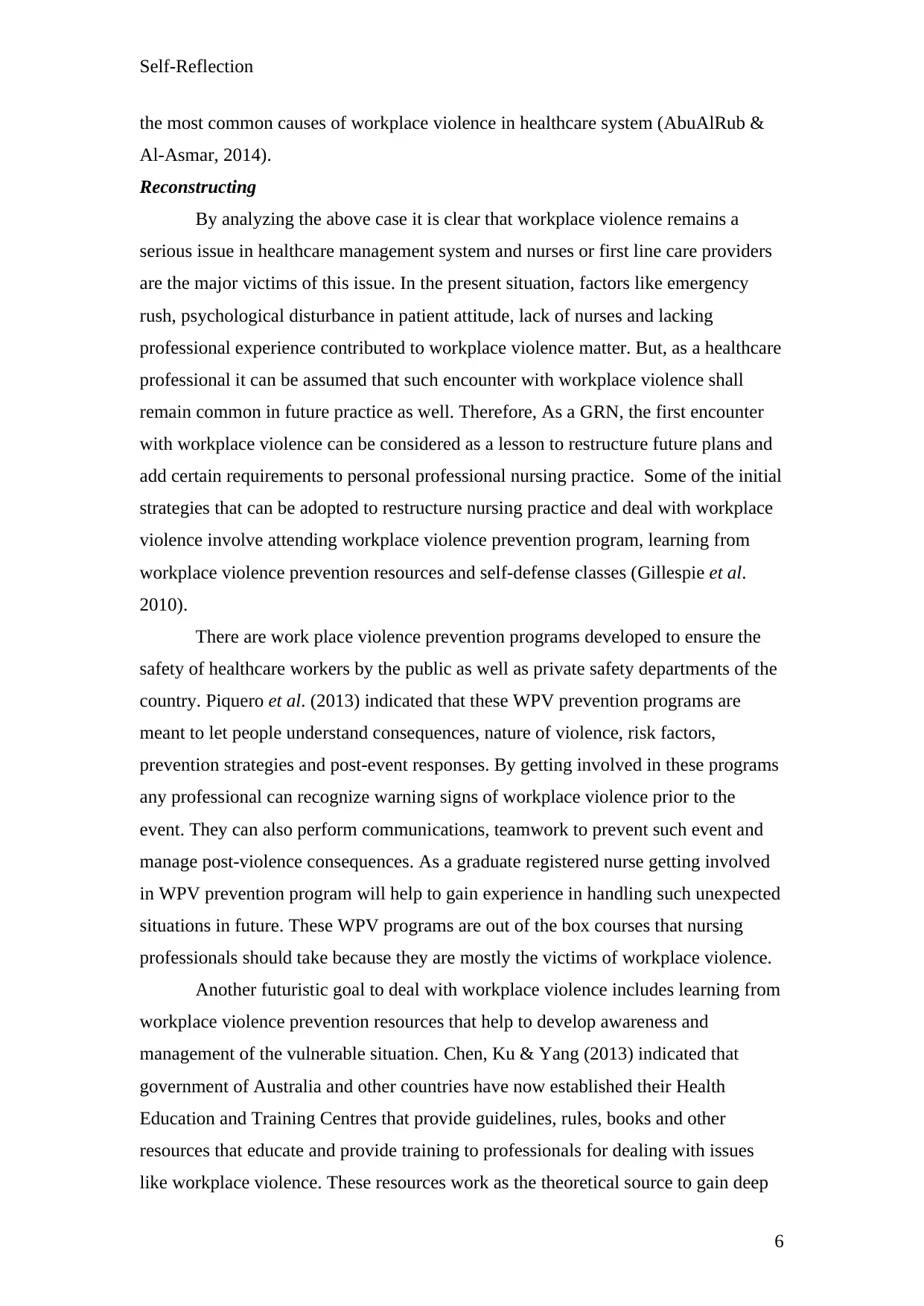
Self-Reflection
the most common causes of workplace violence in healthcare system (AbuAlRub &
Al-Asmar, 2014).
Reconstructing
By analyzing the above case it is clear that workplace violence remains a
serious issue in healthcare management system and nurses or first line care providers
are the major victims of this issue. In the present situation, factors like emergency
rush, psychological disturbance in patient attitude, lack of nurses and lacking
professional experience contributed to workplace violence matter. But, as a healthcare
professional it can be assumed that such encounter with workplace violence shall
remain common in future practice as well. Therefore, As a GRN, the first encounter
with workplace violence can be considered as a lesson to restructure future plans and
add certain requirements to personal professional nursing practice. Some of the initial
strategies that can be adopted to restructure nursing practice and deal with workplace
violence involve attending workplace violence prevention program, learning from
workplace violence prevention resources and self-defense classes (Gillespie et al.
2010).
There are work place violence prevention programs developed to ensure the
safety of healthcare workers by the public as well as private safety departments of the
country. Piquero et al. (2013) indicated that these WPV prevention programs are
meant to let people understand consequences, nature of violence, risk factors,
prevention strategies and post-event responses. By getting involved in these programs
any professional can recognize warning signs of workplace violence prior to the
event. They can also perform communications, teamwork to prevent such event and
manage post-violence consequences. As a graduate registered nurse getting involved
in WPV prevention program will help to gain experience in handling such unexpected
situations in future. These WPV programs are out of the box courses that nursing
professionals should take because they are mostly the victims of workplace violence.
Another futuristic goal to deal with workplace violence includes learning from
workplace violence prevention resources that help to develop awareness and
management of the vulnerable situation. Chen, Ku & Yang (2013) indicated that
government of Australia and other countries have now established their Health
Education and Training Centres that provide guidelines, rules, books and other
resources that educate and provide training to professionals for dealing with issues
like workplace violence. These resources work as the theoretical source to gain deep
6
the most common causes of workplace violence in healthcare system (AbuAlRub &
Al-Asmar, 2014).
Reconstructing
By analyzing the above case it is clear that workplace violence remains a
serious issue in healthcare management system and nurses or first line care providers
are the major victims of this issue. In the present situation, factors like emergency
rush, psychological disturbance in patient attitude, lack of nurses and lacking
professional experience contributed to workplace violence matter. But, as a healthcare
professional it can be assumed that such encounter with workplace violence shall
remain common in future practice as well. Therefore, As a GRN, the first encounter
with workplace violence can be considered as a lesson to restructure future plans and
add certain requirements to personal professional nursing practice. Some of the initial
strategies that can be adopted to restructure nursing practice and deal with workplace
violence involve attending workplace violence prevention program, learning from
workplace violence prevention resources and self-defense classes (Gillespie et al.
2010).
There are work place violence prevention programs developed to ensure the
safety of healthcare workers by the public as well as private safety departments of the
country. Piquero et al. (2013) indicated that these WPV prevention programs are
meant to let people understand consequences, nature of violence, risk factors,
prevention strategies and post-event responses. By getting involved in these programs
any professional can recognize warning signs of workplace violence prior to the
event. They can also perform communications, teamwork to prevent such event and
manage post-violence consequences. As a graduate registered nurse getting involved
in WPV prevention program will help to gain experience in handling such unexpected
situations in future. These WPV programs are out of the box courses that nursing
professionals should take because they are mostly the victims of workplace violence.
Another futuristic goal to deal with workplace violence includes learning from
workplace violence prevention resources that help to develop awareness and
management of the vulnerable situation. Chen, Ku & Yang (2013) indicated that
government of Australia and other countries have now established their Health
Education and Training Centres that provide guidelines, rules, books and other
resources that educate and provide training to professionals for dealing with issues
like workplace violence. These resources work as the theoretical source to gain deep
6
⊘ This is a preview!⊘
Do you want full access?
Subscribe today to unlock all pages.

Trusted by 1+ million students worldwide
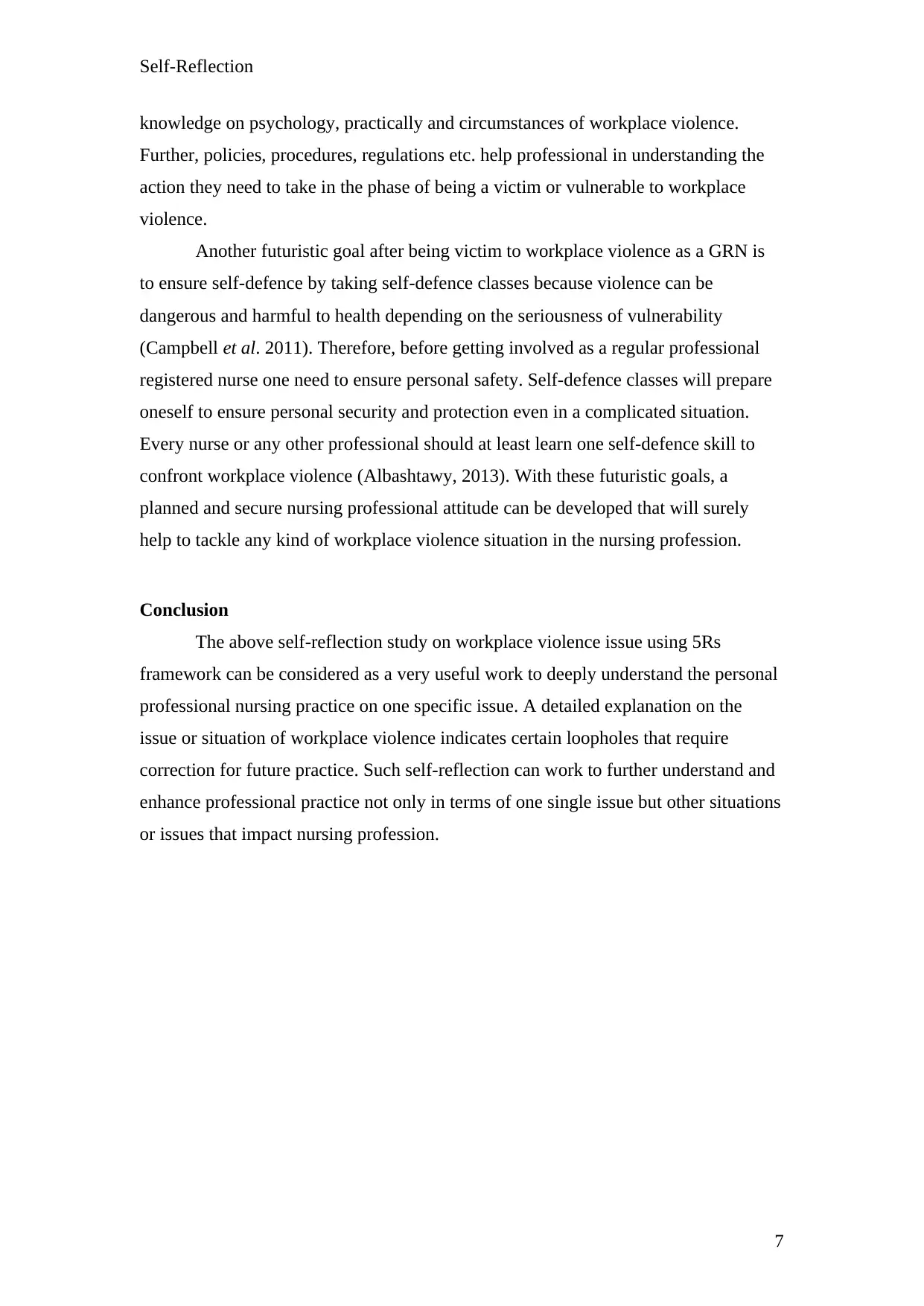
Self-Reflection
knowledge on psychology, practically and circumstances of workplace violence.
Further, policies, procedures, regulations etc. help professional in understanding the
action they need to take in the phase of being a victim or vulnerable to workplace
violence.
Another futuristic goal after being victim to workplace violence as a GRN is
to ensure self-defence by taking self-defence classes because violence can be
dangerous and harmful to health depending on the seriousness of vulnerability
(Campbell et al. 2011). Therefore, before getting involved as a regular professional
registered nurse one need to ensure personal safety. Self-defence classes will prepare
oneself to ensure personal security and protection even in a complicated situation.
Every nurse or any other professional should at least learn one self-defence skill to
confront workplace violence (Albashtawy, 2013). With these futuristic goals, a
planned and secure nursing professional attitude can be developed that will surely
help to tackle any kind of workplace violence situation in the nursing profession.
Conclusion
The above self-reflection study on workplace violence issue using 5Rs
framework can be considered as a very useful work to deeply understand the personal
professional nursing practice on one specific issue. A detailed explanation on the
issue or situation of workplace violence indicates certain loopholes that require
correction for future practice. Such self-reflection can work to further understand and
enhance professional practice not only in terms of one single issue but other situations
or issues that impact nursing profession.
7
knowledge on psychology, practically and circumstances of workplace violence.
Further, policies, procedures, regulations etc. help professional in understanding the
action they need to take in the phase of being a victim or vulnerable to workplace
violence.
Another futuristic goal after being victim to workplace violence as a GRN is
to ensure self-defence by taking self-defence classes because violence can be
dangerous and harmful to health depending on the seriousness of vulnerability
(Campbell et al. 2011). Therefore, before getting involved as a regular professional
registered nurse one need to ensure personal safety. Self-defence classes will prepare
oneself to ensure personal security and protection even in a complicated situation.
Every nurse or any other professional should at least learn one self-defence skill to
confront workplace violence (Albashtawy, 2013). With these futuristic goals, a
planned and secure nursing professional attitude can be developed that will surely
help to tackle any kind of workplace violence situation in the nursing profession.
Conclusion
The above self-reflection study on workplace violence issue using 5Rs
framework can be considered as a very useful work to deeply understand the personal
professional nursing practice on one specific issue. A detailed explanation on the
issue or situation of workplace violence indicates certain loopholes that require
correction for future practice. Such self-reflection can work to further understand and
enhance professional practice not only in terms of one single issue but other situations
or issues that impact nursing profession.
7
Paraphrase This Document
Need a fresh take? Get an instant paraphrase of this document with our AI Paraphraser
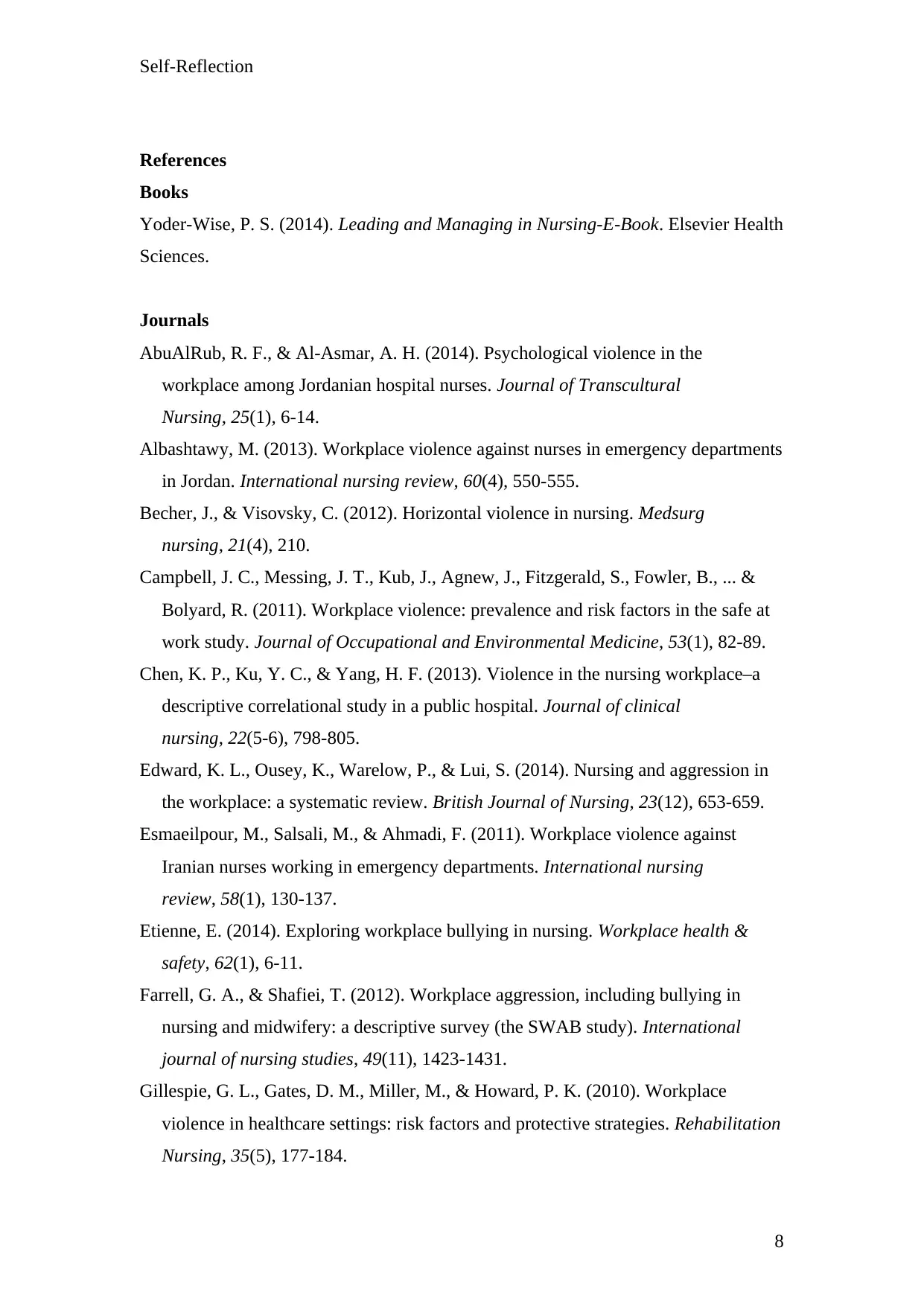
Self-Reflection
References
Books
Yoder-Wise, P. S. (2014). Leading and Managing in Nursing-E-Book. Elsevier Health
Sciences.
Journals
AbuAlRub, R. F., & Al-Asmar, A. H. (2014). Psychological violence in the
workplace among Jordanian hospital nurses. Journal of Transcultural
Nursing, 25(1), 6-14.
Albashtawy, M. (2013). Workplace violence against nurses in emergency departments
in Jordan. International nursing review, 60(4), 550-555.
Becher, J., & Visovsky, C. (2012). Horizontal violence in nursing. Medsurg
nursing, 21(4), 210.
Campbell, J. C., Messing, J. T., Kub, J., Agnew, J., Fitzgerald, S., Fowler, B., ... &
Bolyard, R. (2011). Workplace violence: prevalence and risk factors in the safe at
work study. Journal of Occupational and Environmental Medicine, 53(1), 82-89.
Chen, K. P., Ku, Y. C., & Yang, H. F. (2013). Violence in the nursing workplace–a
descriptive correlational study in a public hospital. Journal of clinical
nursing, 22(5-6), 798-805.
Edward, K. L., Ousey, K., Warelow, P., & Lui, S. (2014). Nursing and aggression in
the workplace: a systematic review. British Journal of Nursing, 23(12), 653-659.
Esmaeilpour, M., Salsali, M., & Ahmadi, F. (2011). Workplace violence against
Iranian nurses working in emergency departments. International nursing
review, 58(1), 130-137.
Etienne, E. (2014). Exploring workplace bullying in nursing. Workplace health &
safety, 62(1), 6-11.
Farrell, G. A., & Shafiei, T. (2012). Workplace aggression, including bullying in
nursing and midwifery: a descriptive survey (the SWAB study). International
journal of nursing studies, 49(11), 1423-1431.
Gillespie, G. L., Gates, D. M., Miller, M., & Howard, P. K. (2010). Workplace
violence in healthcare settings: risk factors and protective strategies. Rehabilitation
Nursing, 35(5), 177-184.
8
References
Books
Yoder-Wise, P. S. (2014). Leading and Managing in Nursing-E-Book. Elsevier Health
Sciences.
Journals
AbuAlRub, R. F., & Al-Asmar, A. H. (2014). Psychological violence in the
workplace among Jordanian hospital nurses. Journal of Transcultural
Nursing, 25(1), 6-14.
Albashtawy, M. (2013). Workplace violence against nurses in emergency departments
in Jordan. International nursing review, 60(4), 550-555.
Becher, J., & Visovsky, C. (2012). Horizontal violence in nursing. Medsurg
nursing, 21(4), 210.
Campbell, J. C., Messing, J. T., Kub, J., Agnew, J., Fitzgerald, S., Fowler, B., ... &
Bolyard, R. (2011). Workplace violence: prevalence and risk factors in the safe at
work study. Journal of Occupational and Environmental Medicine, 53(1), 82-89.
Chen, K. P., Ku, Y. C., & Yang, H. F. (2013). Violence in the nursing workplace–a
descriptive correlational study in a public hospital. Journal of clinical
nursing, 22(5-6), 798-805.
Edward, K. L., Ousey, K., Warelow, P., & Lui, S. (2014). Nursing and aggression in
the workplace: a systematic review. British Journal of Nursing, 23(12), 653-659.
Esmaeilpour, M., Salsali, M., & Ahmadi, F. (2011). Workplace violence against
Iranian nurses working in emergency departments. International nursing
review, 58(1), 130-137.
Etienne, E. (2014). Exploring workplace bullying in nursing. Workplace health &
safety, 62(1), 6-11.
Farrell, G. A., & Shafiei, T. (2012). Workplace aggression, including bullying in
nursing and midwifery: a descriptive survey (the SWAB study). International
journal of nursing studies, 49(11), 1423-1431.
Gillespie, G. L., Gates, D. M., Miller, M., & Howard, P. K. (2010). Workplace
violence in healthcare settings: risk factors and protective strategies. Rehabilitation
Nursing, 35(5), 177-184.
8
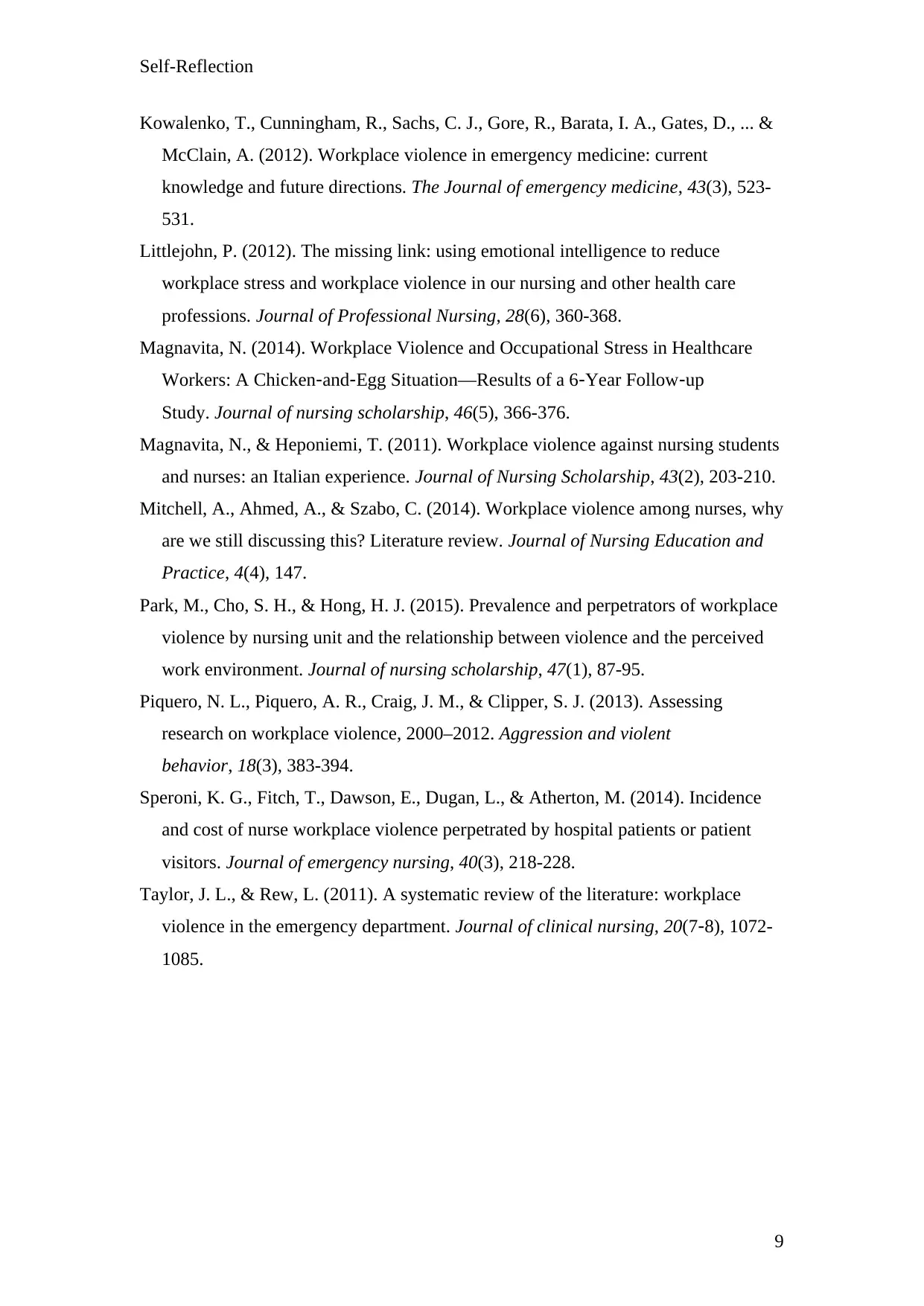
Self-Reflection
Kowalenko, T., Cunningham, R., Sachs, C. J., Gore, R., Barata, I. A., Gates, D., ... &
McClain, A. (2012). Workplace violence in emergency medicine: current
knowledge and future directions. The Journal of emergency medicine, 43(3), 523-
531.
Littlejohn, P. (2012). The missing link: using emotional intelligence to reduce
workplace stress and workplace violence in our nursing and other health care
professions. Journal of Professional Nursing, 28(6), 360-368.
Magnavita, N. (2014). Workplace Violence and Occupational Stress in Healthcare
Workers: A Chicken‐and‐Egg Situation—Results of a 6‐Year Follow‐up
Study. Journal of nursing scholarship, 46(5), 366-376.
Magnavita, N., & Heponiemi, T. (2011). Workplace violence against nursing students
and nurses: an Italian experience. Journal of Nursing Scholarship, 43(2), 203-210.
Mitchell, A., Ahmed, A., & Szabo, C. (2014). Workplace violence among nurses, why
are we still discussing this? Literature review. Journal of Nursing Education and
Practice, 4(4), 147.
Park, M., Cho, S. H., & Hong, H. J. (2015). Prevalence and perpetrators of workplace
violence by nursing unit and the relationship between violence and the perceived
work environment. Journal of nursing scholarship, 47(1), 87-95.
Piquero, N. L., Piquero, A. R., Craig, J. M., & Clipper, S. J. (2013). Assessing
research on workplace violence, 2000–2012. Aggression and violent
behavior, 18(3), 383-394.
Speroni, K. G., Fitch, T., Dawson, E., Dugan, L., & Atherton, M. (2014). Incidence
and cost of nurse workplace violence perpetrated by hospital patients or patient
visitors. Journal of emergency nursing, 40(3), 218-228.
Taylor, J. L., & Rew, L. (2011). A systematic review of the literature: workplace
violence in the emergency department. Journal of clinical nursing, 20(7‐8), 1072-
1085.
9
Kowalenko, T., Cunningham, R., Sachs, C. J., Gore, R., Barata, I. A., Gates, D., ... &
McClain, A. (2012). Workplace violence in emergency medicine: current
knowledge and future directions. The Journal of emergency medicine, 43(3), 523-
531.
Littlejohn, P. (2012). The missing link: using emotional intelligence to reduce
workplace stress and workplace violence in our nursing and other health care
professions. Journal of Professional Nursing, 28(6), 360-368.
Magnavita, N. (2014). Workplace Violence and Occupational Stress in Healthcare
Workers: A Chicken‐and‐Egg Situation—Results of a 6‐Year Follow‐up
Study. Journal of nursing scholarship, 46(5), 366-376.
Magnavita, N., & Heponiemi, T. (2011). Workplace violence against nursing students
and nurses: an Italian experience. Journal of Nursing Scholarship, 43(2), 203-210.
Mitchell, A., Ahmed, A., & Szabo, C. (2014). Workplace violence among nurses, why
are we still discussing this? Literature review. Journal of Nursing Education and
Practice, 4(4), 147.
Park, M., Cho, S. H., & Hong, H. J. (2015). Prevalence and perpetrators of workplace
violence by nursing unit and the relationship between violence and the perceived
work environment. Journal of nursing scholarship, 47(1), 87-95.
Piquero, N. L., Piquero, A. R., Craig, J. M., & Clipper, S. J. (2013). Assessing
research on workplace violence, 2000–2012. Aggression and violent
behavior, 18(3), 383-394.
Speroni, K. G., Fitch, T., Dawson, E., Dugan, L., & Atherton, M. (2014). Incidence
and cost of nurse workplace violence perpetrated by hospital patients or patient
visitors. Journal of emergency nursing, 40(3), 218-228.
Taylor, J. L., & Rew, L. (2011). A systematic review of the literature: workplace
violence in the emergency department. Journal of clinical nursing, 20(7‐8), 1072-
1085.
9
⊘ This is a preview!⊘
Do you want full access?
Subscribe today to unlock all pages.

Trusted by 1+ million students worldwide
1 out of 9
Related Documents
Your All-in-One AI-Powered Toolkit for Academic Success.
+13062052269
info@desklib.com
Available 24*7 on WhatsApp / Email
![[object Object]](/_next/static/media/star-bottom.7253800d.svg)
Unlock your academic potential
Copyright © 2020–2025 A2Z Services. All Rights Reserved. Developed and managed by ZUCOL.



